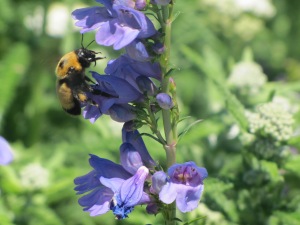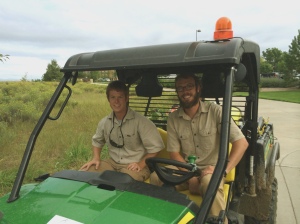 On a warm afternoon a tiger swallowtail butterfly rests on the orange-pink flower of a swamp milkweed (asclepias incarnata). Native bumblebees lumber awkwardly, slowly, seemingly contented as they lazily sample each flower on the stalk of the side-bells penstemon (penstemon secundiflorus), under the warm summer sun.
On a warm afternoon a tiger swallowtail butterfly rests on the orange-pink flower of a swamp milkweed (asclepias incarnata). Native bumblebees lumber awkwardly, slowly, seemingly contented as they lazily sample each flower on the stalk of the side-bells penstemon (penstemon secundiflorus), under the warm summer sun.
As young ospreys test out their fragile wings, slowly gaining strength, a pair of western grebes run across the surface of the lake performing their ancient, miraculous dance. This is not the wilderness, a national park, or even a carefully “preserved” natural area. This is habitat that was intentionally designed and built in the midst of a rapidly growing neighborhood, The Lakes at Centerra.
The concept for this neighborhood, which features “nature in your backyard” as a major marketing piece, is the result of a unique collaboration between a non-profit (High Plains Environmental Center (HPEC), a developer (McWhinney), builders, businesses and residents. Soon a K-8 public school with a STEM focus (Science, Technology, Engineering, and Math) will be added to the mix. Students will be able to utilize the adjacent environmental center, comprised of 275 acres of wetlands, as a “living laboratory”.

This symbiotic relationship between economic and environmental interests provides a hopeful vision for conservation in the 21st century focused not on conserving wild places that already exist but on restoring habitat for wildlife within the neighborhoods that we design and build.
The Lakes neighborhood will consist of 791 units, including single family homes, townhouses and apartments, spanning 300 acres, as well as scores of acres of restored open space and community parks. The development began as an agricultural field, portions of which were weedy and abandoned (one section contained a junk yard with a century of accumulated waste, including an entire railroad car.) The area was substantially regraded creating wetland drainages throughout the neighborhood.
The result is a large scale constructed wetland habitat, spanning more than 20 acres in phase one, which has been seeded with native grasses arranged in zones according to soil moisture. Sedges and rushes will emerge from wetland micro pools, which will remain open water year round. The saturated soils above the wet pools contain native tallgrass species such as Big Bluestem (Andropogon gerardii), Yellow Indian Grass (Sorghastrum nutans) and Switch grass (Panicum virgatum). The higher dryer portions of the open space support short grass species including Blue grama (Bouteloua gracilis), Sideoats Grama (Bouteloua curtipendula) and Western Wheat Grass (Pascopyrum smithii.)
 Gregory Holman, a restoration ecologist with USDA-ARS and an HPEC board member, says; “you can have mosquitos in concrete drainages that hold as little as a quarter inch of water. The difference in these ponds is that here you also have tadpoles, predatory insects and other biological controls that help to regulate mosquito populations while supporting a wide range of wildlife species in the midst of development.”
Gregory Holman, a restoration ecologist with USDA-ARS and an HPEC board member, says; “you can have mosquitos in concrete drainages that hold as little as a quarter inch of water. The difference in these ponds is that here you also have tadpoles, predatory insects and other biological controls that help to regulate mosquito populations while supporting a wide range of wildlife species in the midst of development.”
Since 2006, Centerra has been focused on creating storm water ponds, vegetated with native plants that replicate the ecological function of wetlands, providing wildlife habitat and purifying runoff. In 2008, the document Centerra Guidelines for Natural Areas and Stormwater Drainage, won an environmental stewardship award from the American Society Landscape Architects. The document was the result of collaboration between Ark Ecological Services, BHA (a landscape architecture firm), McWhinney and HPEC.
 Historically the site was high plains grassland dominated by short grasses and shrubs. In 1907, the lake that lies at the heart of HPEC was dug. Known as “Equalizer” this reservoir is part of a working irrigation system and is used for moderating the levels of other reservoirs in the Greeley Loveland Irrigation Company system. A second reservoir “Houts” was dug to the north of Equalizer for John Houts, the great, great grandfather of Chad and Troy McWhinney, the developers of Centerra.
Historically the site was high plains grassland dominated by short grasses and shrubs. In 1907, the lake that lies at the heart of HPEC was dug. Known as “Equalizer” this reservoir is part of a working irrigation system and is used for moderating the levels of other reservoirs in the Greeley Loveland Irrigation Company system. A second reservoir “Houts” was dug to the north of Equalizer for John Houts, the great, great grandfather of Chad and Troy McWhinney, the developers of Centerra.
When the McWhinney’s brought their plan for the 3000-acre development to the City of Loveland, the City stipulated that the development would be 20 percent open space at build out. McWhinney hired an environmental consulting firm (Cedar Creek) to do an assessment of environmentally sensitive areas. The study identified setbacks surrounding the two reservoirs, based on existing vegetation. The setbacks that resulted from this study became the foot print of what would become the HPEC. Tom Hoyt, the president of McStain Neighborhoods, suggested creating a stand-alone 5013c to become the recipient of the land. McWhinney readily embraced the idea and voluntarily imposed an environmental assessment fee which is collected by the City when building permits are issued for projects within Centerra, west of 1-25. The accumulated “environmental assessment fees” will grow to an endowment of four- million dollars by the build out of Centerra.
The use of native plants in residential landscaping blurs the line between restored habitat in open space and backyard gardens. The design guidelines for the neighborhood actively encourage homeowners to utilize native and xeric plants, as well as native lawns.
 As an additional source of revenue the environmental center manages open space for the Centerra Metro District and other land owners. HPEC also grows native plants from locally collected “eco-types.”
As an additional source of revenue the environmental center manages open space for the Centerra Metro District and other land owners. HPEC also grows native plants from locally collected “eco-types.”
The native plants are used for landscaping within the neighborhood and in restoration projects. The proceeds from both the nursery and open space management programs fund the centers public outreach and environmental education programs.
HPEC is in the process of constructing the visitor center located within The Lakes at Centerra Neighborhood. The visitor center will officially launch on May, 16, 2015 with a public event including a native plant sale and presentations on pollinators, sustainable landscaping and sustainable living.
For more information visit http://www.suburbitat.org